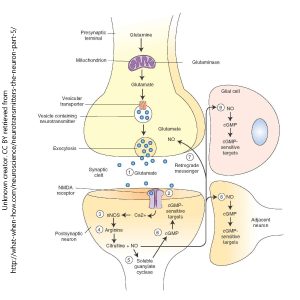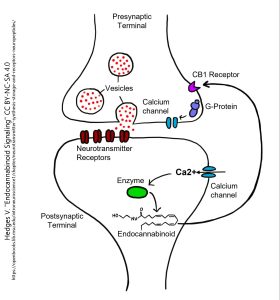Retrograde Information Transmission at the Synapse
Caleb Bevan
Objective 4: Explain retrograde modulation of synaptic activity in presynaptic neurons.
Ever since Sherrington proposed the concept of a synapse, it has been understood that information transfer is in a single direction: from presynaptic cell to postsynaptic cell. In electrical engineering terms, the synapse was believed to be a diode. A diode conducts current in one direction, and is an essential part of any computer circuitry. This model was satisfying to the neuroscientists of the 1950s and 1960s because as they were building computers, they thought they were building circuitry that worked the same as the human brain.
 The human brain is not that simple, and in recent years, the diode model of a synapse has broken down completely. We now understand that synapses often transfer information in the opposite direction: from postsynaptic to presynaptic.
The human brain is not that simple, and in recent years, the diode model of a synapse has broken down completely. We now understand that synapses often transfer information in the opposite direction: from postsynaptic to presynaptic.
When we look at modifiable synapses in the next section of the textbook, for example, we will see that activation of the NMDA-type glutamate receptor allows Ca2+ ions to enter the postsynaptic neuron. Ca2+ acts on an enzyme called neuronal nitric oxide synthase (nNOS). The name of this enzyme tells us where it is found (in neurons), and what it does (synthesizes nitric oxide).

The amino acid arginine is combined with oxygen to form a compound called citrulline, water, and most importantly, the gaseous neurotransmitter nitric oxide. Because nitric oxide (NO) is a gas, it can freely diffuse in all directions from where it is made. (It is also quite unstable, so it only acts for as long as the enzyme nNOS is able to make NO.) When it reaches the presynaptic terminal, it acts to increase the amount of glutamate released from the presynaptic cell. As we will see later, this sets up a positive feedback loop because more glutamate release leads to the insertion of more glutamate receptors in the postsynaptic membrane.
 Another striking example of retrograde signaling is the target of a familiar drug: cannabis. The psychoactive ingredients in cannabis, primarily Δ9-tetrahydrocannibinol (THC), mimic a naturally occurring neurotransmitter called anandamide. (Ananda is a Sanskrit word for “bliss” and it is a chemical compound known as an amide, hence the name.) Anandamide is an example of an endocannabinoid, a compound made by the body which mimics the active compounds in cannabis. Endocannabinoids are made by the postsynaptic neuron by a Ca2+-dependent enzyme. Because they are small, lipid-soluble molecules, they are capable of traveling through the cell membrane. Anadamide and other endocannabinoids diffuse retrogradely (in the direction opposite synaptic transmission) and act on cannabinoid receptors (CB receptors) on the presynaptic membrane. Neurons in particular tend to have the cannabinoid receptor type called CB1. The CB1 receptor is a G protein-coupled receptor, and acts to decrease the amount of glutamate released by the presynaptic cell.
Another striking example of retrograde signaling is the target of a familiar drug: cannabis. The psychoactive ingredients in cannabis, primarily Δ9-tetrahydrocannibinol (THC), mimic a naturally occurring neurotransmitter called anandamide. (Ananda is a Sanskrit word for “bliss” and it is a chemical compound known as an amide, hence the name.) Anandamide is an example of an endocannabinoid, a compound made by the body which mimics the active compounds in cannabis. Endocannabinoids are made by the postsynaptic neuron by a Ca2+-dependent enzyme. Because they are small, lipid-soluble molecules, they are capable of traveling through the cell membrane. Anadamide and other endocannabinoids diffuse retrogradely (in the direction opposite synaptic transmission) and act on cannabinoid receptors (CB receptors) on the presynaptic membrane. Neurons in particular tend to have the cannabinoid receptor type called CB1. The CB1 receptor is a G protein-coupled receptor, and acts to decrease the amount of glutamate released by the presynaptic cell.
Media Attributions
- Retrograde signaling © Nwachukwu Favour Onyinyechi, Ikwebe Joseph, Kerenhappuch Isaac Umaru, and Isaac John Umaru is licensed under a CC BY-SA (Attribution ShareAlike) license
- Chemical reaction nitric oxide synthesis © PubChem is licensed under a Public Domain license
- Retrograde signaling by endocannibinoids © Valerie Hedges is licensed under a CC BY-NC-ND (Attribution NonCommercial NoDerivatives) license

